Caring for an English Bulldog: Tips and Basic Info
The Ancestry of the English Bulldog
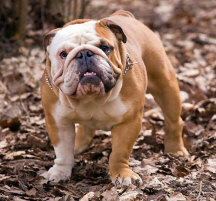 The
earliest ancestors of the English Bulldog were dogs that were mastiff-like in
appearance who were known as the Molossians. They were used for hunting,
guarding, and herding activities by the Greeks and Romans. Later, in the Middle
Ages, the dogs were used for bull-baiting events in Britain. The
earliest ancestors of the English Bulldog were dogs that were mastiff-like in
appearance who were known as the Molossians. They were used for hunting,
guarding, and herding activities by the Greeks and Romans. Later, in the Middle
Ages, the dogs were used for bull-baiting events in Britain.
A Little Bit about the Dog’s History
In the early 19th century, bull-baiting was declared illegal. Therefore the
Bulldog's ancestors were no longer needed for fighting bulls. Through the
practice of selective breeding, breeders worked to get rid of the dog’s
aggressiveness while keeping its physical attributes intact. These efforts led
to the American Kennel Club's endorsement of the English Bulldog in 1886.
Bulldog Related Breeds
Besides the English Bulldog, Bulldog related breeds include the American
Bulldog, the American Pit Bull Terrier, the Old English Bulldogge, the Banter
Bulldogge, the Boston Terrier, the Alapaha Blue Blood Bulldog, the French
Bulldog, and the Valley Bulldog.
Physical Characteristics
Bulldogs exhibit coats that can be red brindle, light yellow, white, or fawn, or
a mix of any one or more of the mentioned hues. Featuring broad jaws and
underbites, the compact, short-legged canines are both friendly and gentle and
are much more amiable than what you’d surmise by their appearance. Growing about
a foot to a foot and a half long, the dogs weigh, on average, around 50 pounds.
The Ideal Dog for a Small Space
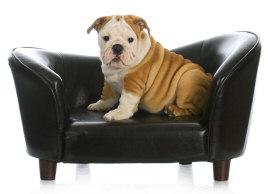 Because
it dislikes excessive exercise and conveys a calm and patient demeanor, the dog
is the ideal pet for a couch potato or anyone who lives in a small space, such
as an apartment. Because
it dislikes excessive exercise and conveys a calm and patient demeanor, the dog
is the ideal pet for a couch potato or anyone who lives in a small space, such
as an apartment.
A Kid-and-Family-Friendly Canine
The dogs are also kid-friendly as well. They enjoy playing with kids and, unlike
some dogs, do not exhibit any kind of overt aggressiveness. Therefore, they make
a good pet for a family. While the dog is energetic and spirited as a youngster,
it tends to become more and more laid-back with the passing of time. Dogs in the
breed live about ten years.
Keep the Dog Exercised
Even though they may possess certain health issues, English Bulldogs, all in
all, are easy-care pets. That’s because they often stay planted in the same spot
most of the time. However, that doesn’t mean they shouldn’t be walked and
exercised daily. Exercise is a necessity, especially since the stocky canines
tend to put on weight more easily than other dogs.
Introducing a Bulldog Puppy into Your Household
When you bring a Bulldog puppy home, you should also have a copy of the dog’s
pedigree and a record of immunizations and wormings. Bulldogs, when pups, need a
lot in the way of cuddling, rest, and nutrition. Help your pup easily transition
into his new home by obtaining the feeding routine of the breeder and following
it. Use the same food and supplementation and set up a regular feeding place for
your puppy. Establish a separate sleeping area for him as well. During the first
week, take your pup to a vet along with his immunization record.
Feeding Your Dog
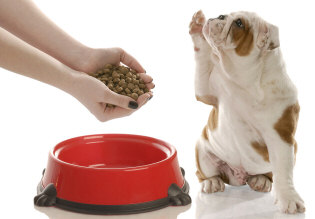 Breeders
of Bulldogs typically feed puppies from two to four months of age four times
each day. Puppy kibble is made softer by adding lukewarm water. After the puppy
turns four months old, taper down the feedings to three per day and reduce them
down to two feedings by the time the dog reaches six months of age. After your
dog matures, feed him once or twice a day. At that time too, switch his kibble
from puppy food to dried adult dog food. Breeders
of Bulldogs typically feed puppies from two to four months of age four times
each day. Puppy kibble is made softer by adding lukewarm water. After the puppy
turns four months old, taper down the feedings to three per day and reduce them
down to two feedings by the time the dog reaches six months of age. After your
dog matures, feed him once or twice a day. At that time too, switch his kibble
from puppy food to dried adult dog food.
Make Changes Gradually
Make any food changes gradually by supplanting a small portion of the old dog
food with the new food until the former food is entirely replaced. Use stainless
steel food and water dishes instead of plastic. You’ll also want to buy a collar
and lead. Make sure that both the collar and lead are lightweight and switch to
a heavier leather lead when your dog becomes an adult.
Keep Plenty of Safe Chew Toys on Hand for Your Dog to Chew
Bulldogs don’t give up chewing things after puppyhood. So, make sure your
Bulldog’s needs are met along these lines by supplying him with plenty in the
way of safe toys that he can chew. Never give a Bulldog a toy that is made of
rawhide as it can be fatal. Again, because the dog likes to chew, he can choke
on the pieces. In addition to chew toys, you can also use larger balls (sized
not to get lodged in the throat) or knotted socks for play activities.
Grooming Your Pet
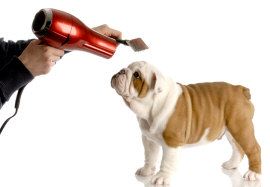 A
grooming table and grooming supplies are must-haves as well and should include a
brush with rubber or soft bristles, nail cutter, whisker scissors, tub, doggy
shampoo and conditioner. Brush your dog’s hair three times a week, bathe him
once a month, and trim his nails every couple weeks. A
grooming table and grooming supplies are must-haves as well and should include a
brush with rubber or soft bristles, nail cutter, whisker scissors, tub, doggy
shampoo and conditioner. Brush your dog’s hair three times a week, bathe him
once a month, and trim his nails every couple weeks.
The Proper Way to Brush Your Dog’s Hair
You’ll find that your Bulldog will love getting brushed. Begin brushing by
starting at the rear and brushing against the grain. Then brush your dog’s hair
with the grain. Follow brushing with a towel rubdown, which will keep your dog’s
hair looking its shiniest.
Brush your Bulldog more often when it sheds, during the spring and autumn,
and give it rubdowns more frequently then as well. Because Bulldogs are
susceptible to itchy skin and dermatitis, the brushings and rubdowns will get
rid of the excess dead skin and hair and help distribute the dog’s natural oils.
Clipping Your Bulldog’s Nails
Trim your dog’s nails, again, every couple of weeks, clipping them short with
either a scissors or guillotine kind of clippers. Whichever kind you use, make
sure that the clippers are always sharp, replacing the tool whenever the blade
begins to dull.
Be Careful Not to Cut to the Quick
Be very careful not to cut to the quick in the nail, or the pink end of the
vein. If you walk your dog regularly, he’ll naturally wear his nails down so you
won’t have to trim them as much. Dogs either have white or black nails. Black
nails seemingly wear down more easily than the white nails do.
Flea Prevention Measures
Bulldogs can develop serious skin issues from fleas. Therefore, prevention is
the best remedy. Change your dog’s bedding frequently and brush him often.
Bulldogs are not fans of flea collars and therefore the necklaces are not the
best solution for keeping fleas away from your pet. Instead, use a good flea
shampoo or wash away soap residue with an anti-flea rinse. Flea dips and sprays,
as suggested by your vet, also help deter the pests.
Cleaning and Smoothing Bulldog Wrinkles
Buy Vaseline to moisten your dog’s nose and soothe the wrinkles around his eyes.
Ointment is also useful for cleaning other wrinkles and the ears. Use Q-tips for
cleaning the ears or for administering medicines. Cotton balls are also helpful
for applying medications or keeping water out of the dog’s ears while he is
being bathed.
Cleaning the Tail Pocket
Bulldogs sometimes have a tail that is set inside a pocket. Therefore, the
pocket will need to be cleaned and dried regularly too. Clean the pocket often
with cotton balls so it’s more comfortable for your dog. Apply ointment after
you dry the pocket with a soft towel.
Using a Crate: Make Sure It’s Made of Wire
Use a wire crate to housetrain your pet or for traveling. A wire crate is better
with respect to air ventilation and circulation. To keep him well-hydrated, buy
a stainless steel water dish that can hook to the side of the crate. Or, buy a
safety harness for your dog if your car is too small to accommodate a crate.
Teaching Your Dog Basic Commands
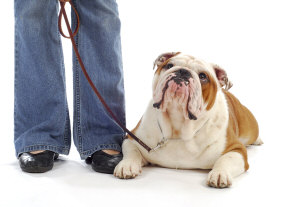 Bulldogs
easily learn most of the basic commands, such as “Stay,” “Lie Down,” “Come,” and
“Heel.” While the dogs are amiable and compliant, they do have a stubborn streak
too. Therefore, make sure that the training you provide your dog is short in
duration and fun. Offer an affectionate pat or a healthy treat when your dog
responds to your given command. Bulldogs
easily learn most of the basic commands, such as “Stay,” “Lie Down,” “Come,” and
“Heel.” While the dogs are amiable and compliant, they do have a stubborn streak
too. Therefore, make sure that the training you provide your dog is short in
duration and fun. Offer an affectionate pat or a healthy treat when your dog
responds to your given command.
Be Kind Yet Firm
Be kind yet firm when you’re training your Bulldog puppy. Only deal out soft
reprimands when your dog doesn’t obey. For example, if your Bulldog pup does not
do as it’s told, speak softly but sternly, ignore him, or give his leash a
gentle pull.
Your Bulldog’s Bed
Bedding material for Bulldogs can range from dog beds to bedding in the form of
cotton blankets or rugs. Don’t give your dog a bed frame made of whicker as the
dog likes to chew and will eventually annihilate it. A faux sheepskin rug is a
good choice as it is soft and you can easily wash it and keep it clean.
Housetraining Your Pet
When housetraining your dog, establish a regular routine. That means taking your
dog outside to the same spot each day. Take him out after he gets up, after
meals, about every two hours during his waking hours, and before he goes to
sleep.
Always praise your pet when he goes on his spot and move out of the area as
soon as he finishes. If you see your pet sniffing indoors, take him outside
right away. Also, if he begins to defecate or urinate in the house, firmly say
“NO!” and take him outside without delay. By practicing patience and sticking to
a regular schedule, you’ll eventually get your Bulldog to go outside without any
prompting.
Drooling Can Be An Issue
English Bulldogs tend to slobber every now and then, with drooling often
occurring soon after the dog eats or drinks. Should it shake its body or head,
watch out for a spit spray.
The Dogs Don’t Bark A Lot But They Do Make Other Sounds
English Bulldogs will not, like some dogs, bark to distraction. Nevertheless,
that doesn’t mean they are necessarily quiet. Again, because of their flat and
short face, they often make snorting and wheezing sounds and frequently snore
while they’re asleep.
The following video highlights some snoring Bulldogs:
A Dog with Special Health Needs
If you’ve just acquired or adopted an English Bulldog, then you already know the
special canine also requires a specific kind of care. No doubt, Bulldogs have
personalities and traits that are definitely unique to them. One of the major
conditions that English Bulldogs suffer from is brachycephalic respiratory
syndrome, which presents various health issues for several dog breeds.
Brachycephalic Syndrome: The Reason for the Condition
When you break down the word “brachycephalic,” it is translated into “brachy,”
for “short” and “cephalic,” for “head.” Therefore, brachycephalic (short head)
syndrome refers to a respiratory condition that affects dog breeds with flatter
faces, such as the English Bulldog, Pug, Pekingese, Shih Tzu, or Boston Terrier.
Selective breeding has caused these dog breeds to have an upper jaw that is
compressed and a lower jaw that is proportionate to their bodies. As a result, a
dog with brachycephalic respiratory syndrome can possess certain physical
anomalies that can compromise its respiration or ability to breathe.
Physical Anomalies Associated with Brachycephalic Syndrome
Pets with brachycephalic syndrome may possess one of the following physical
anomalies:
- An elongated soft palate. The palate, which flaps downward toward
the throat, can cause the dog to snort or make similar sounds. While all
brachycephalic dogs suffer from the deviation, it can be a major cause of
breathing issues for an English Bulldog. If the dog barks or pants
excessively, the throat can swell, which can lead to serious problems with
respiration. To reduce the risk, surgery is recommended. Trimming the
elongated flap will therefore lessen any snorting sounds and ease breathing
difficulties.
- Everted laryngeal saccules can develop when a Bulldog’s saccules
or ventricles on its larynx turn inside out. The saccules are made up of two
small pockets in the throat, which, if the dog has problems breathing, turn
into protuberances. If surgery is indicated, then surgery for an elongated
soft palate should be facilitated as well.
- Stenotic nares are another physical characteristic of
brachycephalic canine breeds. Stenotic nares refer to nostrils that are
narrow or pinched, and are yet another reason why Bulldogs snore and snort.
You can have the dog’s nostrils widened when you have it neutered or spayed.
One of a number of resection methods can be used, including laser ablation.
Procedures Used for Widening the Bulldog’s Nostrils
Surgical procedures for widening the nostrils include the Trader’s technique (alar
wing amputation), horizontal wedge, vertical wedge, and punch resection. None of
the aforementioned techniques is advised over the other as the patient’s
surgical needs and surgeon’s experience both play a part in the type of
technique that is used.
However, that being said, laser ablation or state-of-the-art laser surgery
provides a number of benefits, including less pain for the patient, reduced
chance for infection, and quicker recovery.
The following video demonstrates laser surgery for stenotic nares:
Take Preventative Measures Early in Your Dog’s Life
If brachycephalic syndrome is not addressed in its first stages, then the
condition can lead to collapse of the larynx and tracheostomy surgery. The
procedure involves creating a hole in the neck for the trachea and inserting a
tracheostomy tube.
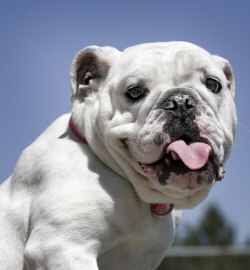 Brachycephalic
dogs, such as Bulldogs, can exhibit facial folds as well, all which can lead to
skin irritations and dermatitis. Therefore, it’s important to clean and examine
the folds regularly for any sign of infection or redness. The broad heads of
English Bulldogs can present a problem during labor too. Typically, Caesarean
section is recommended when a dam delivers its puppies. Brachycephalic
dogs, such as Bulldogs, can exhibit facial folds as well, all which can lead to
skin irritations and dermatitis. Therefore, it’s important to clean and examine
the folds regularly for any sign of infection or redness. The broad heads of
English Bulldogs can present a problem during labor too. Typically, Caesarean
section is recommended when a dam delivers its puppies.
Don’t Over-exercise Your Pet in the Summertime
While a Bulldog can suffer from breathing difficulties in hot temperatures, he
usually fares quite well in a temperate climate. You just need to make sure that
you do not compromise your dog’s health by allowing him to get too heavy or
exercising him too much in the heat.
Lessening the Effects of Heat Stress
A dog that has a snout, or a dog whose face isn’t flat like a Bulldog's, can
more efficiently pant in order to get cool. That's because a Bulldog must exert
more effort in order to move the same quantity of air over the respiratory
tract. As a result, the airways can become swollen after a while. That’s why
heat stress can be more of a problem for a Bulldog than other pets.
When it’s especially hot, make sure that you keep your Bulldog in air
conditioned environments and that he is kept well-hydrated. He should be
consistently monitored when he’s outside in order to prevent heat stroke. Also,
when the dog is a pup, get him used to eating cubes of ice – no doubt something
he’ll appreciate in the summertime.
Conditions or symptoms related to a heat stroke include:
- Excessive panting
- Excessive drooling
- Fast heart rate
- Fatigue and weakness
- Red tongue
- Confused behavior
- Vomiting
What to Do if Your Dog Becomes Overheated
A Bulldog suffers from heat stroke when it can no longer maintain a normal
temperature of approximately 101 degrees Fahrenheit. If the dog’s temperature
rises above 106 degrees Fahrenheit, you have to act swiftly as the internal
organs start to break down at this point. Also, just because a Bulldog may be in
water, he can still overheat, especially if the water is above 75 degrees
Fahrenheit. Therefore, if you believe your dog is overheated, hose him down with
cool water or place him in cool water to lower his body temperature. Call your
vet immediately for further assistance.
Major Health Conditions Associated with the Bulldog
Needless to say, veterinarian care is generally more expensive for a Bulldog pet
as the dog is more prone than other breeds to suffer from such health conditions
as an elongated soft palate, a small windpipe, allergies, heart problems, eyelid
anomalies, corneal ulcers, hyperthyroidism, kidney disease, head tremors, and
dermatitis.
Wonderful, Companionable Pets
English Bulldogs make wonderful, companionable pets. Just make sure that you
give your dog plenty of love and affection and become acquainted with a vet who
understands the special health care needs the Bulldog breed requires.
The following video gives a brief summation or one more overview of the
English Bulldog:
Pets
Top Lists:
18 Richest Animals in the World
15 Exotic Pets You Could Own Today
Top 20 Common Substances That Are Toxic to Cats and Dogs
Informational:
Animal Actors: Pets in the Film, TV, and Print Industry
Caring for a Yorkshire Terrier: Facts You Should Know
Caring for a Pig as a Pet: The Pot-bellied Pig and the Micro Pig
Difference Between a Cat Person And a Dog Person
Should You Microchip your Cat or Dog?
How to Raise and Care for Pygmy Goats
Caring for Unique Pets: The Leopard Gecko
Use Food-Grade Diatomaceous Earth to Kill Fleas Naturally
Dogs:
Top Lists:
Top 15 Dog Breeds For Home Protection
15 Fascinating Facts About The Mastiff
Informational:
How To Teach Your Dog to Hunt for Truffles
Caring for an English Bulldog: Tips and Basic Info
Cranial Cruciate Ligament (CCL) Tears in Dogs: Treating the Injury
How To Keep Your Dog free of Heartworm Disease
Dog With Separation Anxiety?
Cats:
Top Lists:
Top 6 Qualities in an Awesome Cat
Informational:
How to Control Fighting Felines
How to Get Your Cat to Exercise
Fish:
Fish 101 for the Hobbyist: The Fish’s Body and Senses
Buying a Saltwater Aquarium: What You Need to Know
Graduating to a Saltwater Tank
|